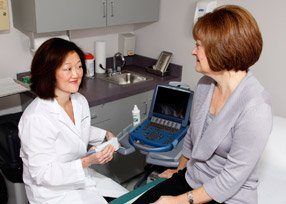Breast Care

We understand that breast evaluation can be a frightening experience. At Andover Surgical Associates, we strive to provide caring, prompt, and up-to-date breast health services. Led by Dr. Nancy Cho Landay, our team offers state-of-the-art procedures in the evaluation, diagnosis, and treatment of breast disease.
Other Breast Health Services include:
-
- Breast cancer screening, particularly for patients at high risk for breast cancer, and breast cancer risk assessment
- Evaluation and management of a variety of breast problems including:
- Breast cancer
- Abnormal mammogram, ultrasound, or MRI
- Breast lump
- Breast pain
- Nipple discharge
- Nipple/areola/skin issues
- Second opinion
- Diagnostic and minimally invasive procedures performed in the office including:
- Diagnostic ultrasound
- Ultrasound-guided cyst aspirations
- Ultrasound-guided core biopsies of breast lumps/ultrasound abnormalities
- Stereotactic core biopsies of mammographic abnormalities
- Surgical procedures performed in the operating room including:
- Lumpectomy
- Sentinel lymph node biopsy
- Biozorb marker placements for breast cancer
- Hidden Scar surgery for breast-conserving surgery and mastectomy
- Skin-sparing and nipple-sparing mastectomy in conjunction with immediate or delayed reconstruction of the breast by our plastic surgery colleagues
Breast Cancer Facts
The most common sign of a breast cancer is a new lump or mass. A lump that is painless, hard, and has uneven edges is more likely to be a cancer, but breast cancers can also be soft, tender and rounded. It’s important to have any breast lump you notice evaluated by a doctor. Other signs of breast cancer can include swelling of all or part of the breast, skin irritation or dimpling, breast pain, nipple pain, a new turning-in (inversion) of the nipple, nipple discharge other than milk, scaling, redness, or thickening of the nipple or breast skin, and a lump in the armpit. You should consult your doctor if you notice any of these findings.
One in eight U.S. women, sometime in their lifetime, will be found to have invasive breast cancer. Nearly 190,000 women in the U.S. in 2009 will be diagnosed with breast cancer. There are currently 2 ½ million breast cancer survivors living in the U.S.
Breast cancer is the most common cancer other than skin cancer in U.S. women. It is the second most common cause of cancer death in U.S. women after lung cancer.
Rates of death from breast cancer are decreasing probably because of earlier diagnosis and treatment.
We do not yet know exactly what causes breast cancer, but there are risk factors which are known to be linked to breast cancer. Some of these risk factors are things that can be changed, such as smoking and obesity, while others, such as gender, race, and family history cannot.
Five to ten percent of breast cancer is felt to be due to genetic changes (mutations) on certain genes, most commonly the BRCA1 and BRCA2 genes. It is important to remember that 70-80% of women with breast cancer have no family history of the disease.
The earlier breast cancer is found, the better the chances are that treatment will work.
About one in 10 women who get a mammogram will need additional pictures taken. Most of these women do not have breast cancer, so don’t be alarmed if this happens to you. It is estimated that only two to four mammograms out of 1,000 mammograms leads to a cancer diagnosis.
There are many different picture (imaging) tests available to evaluate the breast tissue for possible breast cancer. These include mammography, ultrasound, MRI, and ductography (galactography).
A biopsy is done to determine whether or not there is a breast cancer or other breast abnormality. There are many types of biopsies available and the type of biopsy is best chosen after consultation with your surgeon regarding your specific clinical situation. These include fine needle aspiration, ultrasound-guided core biopsy, stereotactic core biopsy, and open biopsy.
